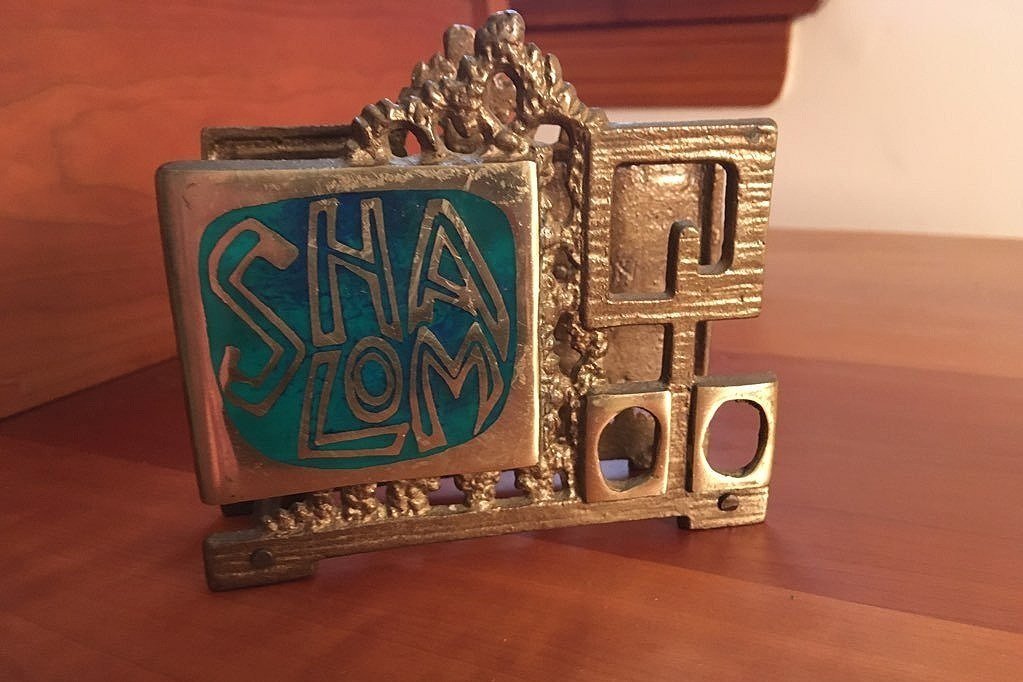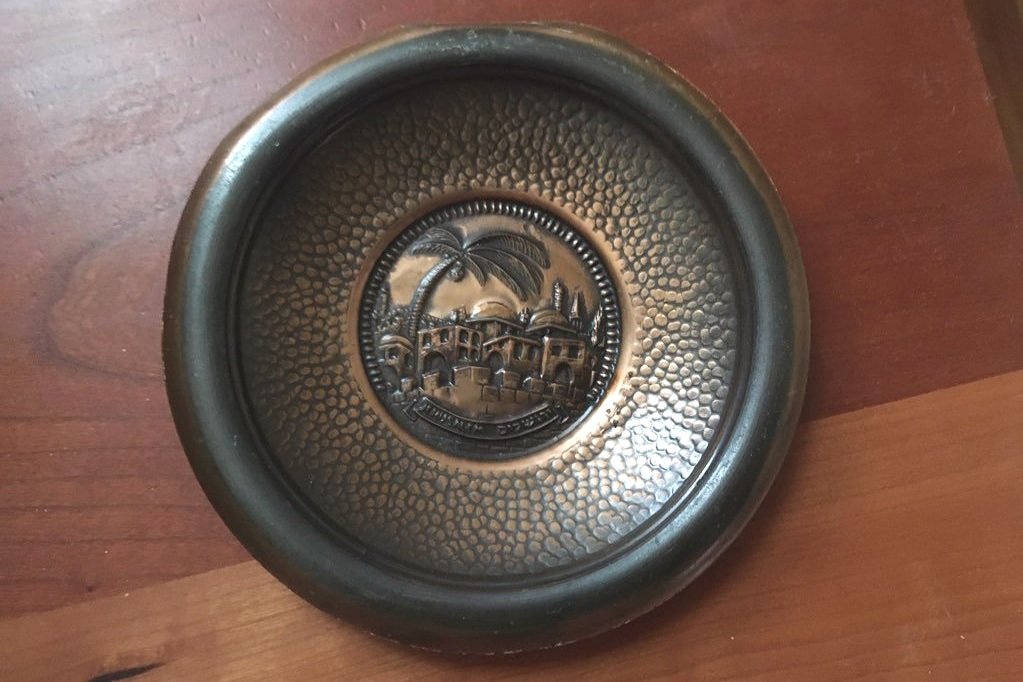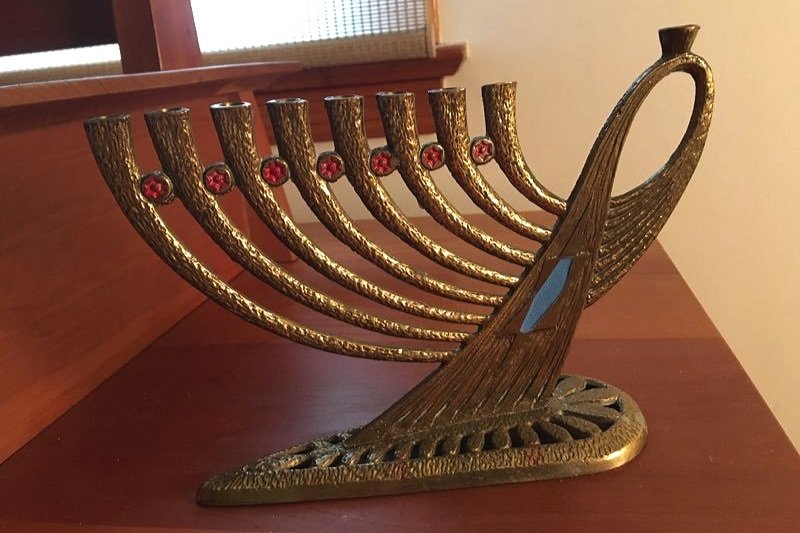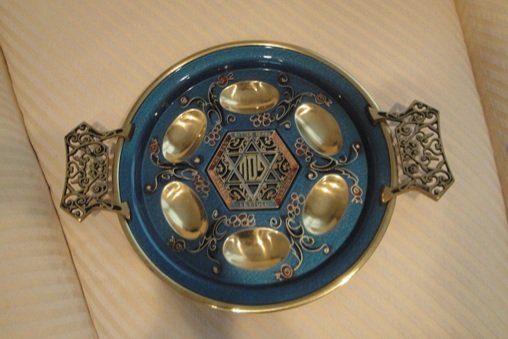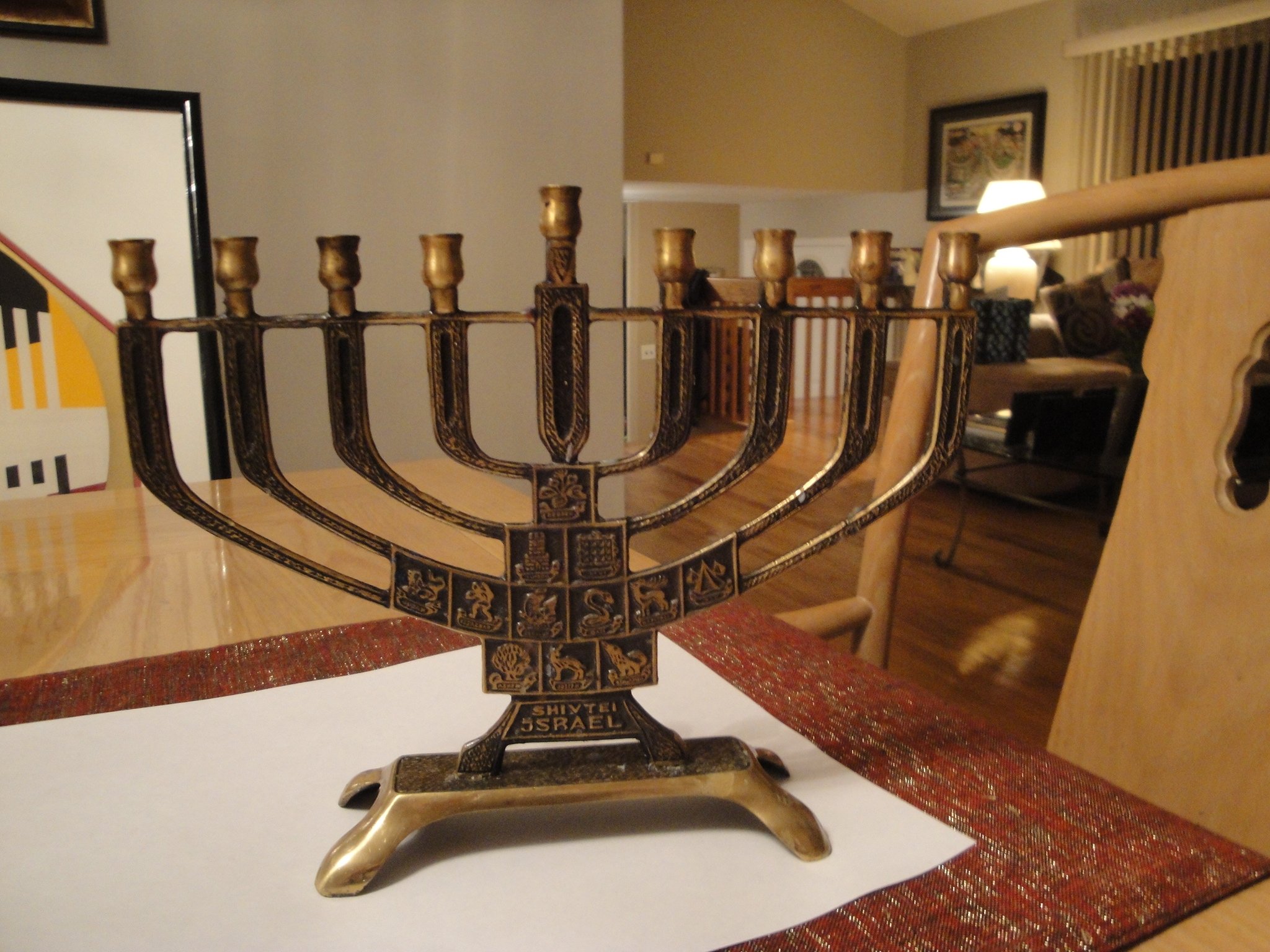Israeliana: Unexpected Relics and Souvenirs from the 1930s - 1970s with Value
Editorial Note:
We are pleased share the second installment of an article series by the appraiser and scholar Dr. Rachael Goldman, AAA, who is an expert in appraising Judaica. Dr. Goldman’s previous article can be read here.
What is the difference between Israeliana and Jewish Art or Judaica?
Often times when the general public thinks about the arts of Israel, it is blended into the larger category of Judaica or Jewish Art, without a contextual base of understanding. Another misconception of Israeliana is that it is an off-shoot of the Bezalel School. The arts of Israel are also considered Art of the Holy Land, which features maps from the late 19th century into the early 20th century. These maps highlight the flora, fauna, and natural resources of the land of Palestine. Instead, let us now consider the handiworks and mass-produced items that put Israel on the map and economically signified the most amount of change. Israeliana is probably more recognizable to the ordinary viewer than they may have considered. This field grew out of a subset of Judaica because of collectors.[1] It is time to consider this type of art form as its own category and its contributions to the larger category of global 20th Century Decorative Arts.[2]
Originally these items would have been considered irrelevant or just odds and ends that would have been dispersed off in an estate sale. But now serious money is paid for these types of ephemeral items. An "Israeliana" exhibit in 2021 at the Israel Museum proved that there was a need to show pieces in context.[3] The recent rediscovery of these pieces has also prompted a reevaluation of the value of these pieces, especially for the commonplace examples and the more rare examples. Originally some pieces (like those by A.N. Oppenheim and Wainberg) had labels from their company; affixed by a string. Some firms like Hakuli had stickers placed on them with the price. [4]
Israeliana examples are made from metal and enamel painting, largely outfitted and assembled with screws. In some cases, larger portions were filled with an enameling or paint created to mimic or imitate Eilat stone or jasper stone. This technique was similar to cloisonné. Some pieces were designed to look like archaeological pieces just dug out of the ground with a verdigris surface.[5] Another decorative technique employed enameling to create a small mosaic with tesserae on the surface, imitative of mosaics from the Romano-Byzantine period. Individuality was achieved with hand-painted works from the firms of Hakuli and Oppenheim.
Sabra Bookends, image courtesy of and copyright Dr. Rachael Goldman
Dayagi Bookends, image courtesy of and copyright Dr. Rachael Goldman
Workshops grew up around Tel Aviv and Jerusalem in the early 1930s - 1940s, marketing their wares from their place of creation, through a third party and then selling them through tourist shops. Catalogs, Jewish Federations, synagogues, and Jewish interest groups all played a role in the distribution of these metalwares for the love and creation of a new nation. Many of these items even had the term "Palestine" inscribed or marked "Made in Palestine" on the item. These pieces can either be categorized as a part of the Art Deco, Bauhaus, Brutalist, or Mid-century Modern. By and large, these pieces fit nicely and categorically into the new streamlined studio arts interior of the mid-century modern vocabulary. Many of these pieces allowed the Jewish homemaker to create a space for themselves that celebrated the pride of a new Jewish homeland.
Were all the pieces made exclusively for Jewish purposes? Not exactly.
The subject matter varied widely and was representative of the periods of 1930s through 1970s, adjusting only slightly with each decade. The items were also trying to capture the imagination of Israel, while catering to the tastes of Americans. There was a Jewish consciousness attached to the creation of these pieces. People living in Israel did purchase these items. Examples of subject matter included:
· Items with utilitarian, everyday purposes for the house including: candy dishes, ashtrays, desk compendium (envelope openers), trivets, plaques, bookends, napkin holders, business card holders, bottle openers, corkscrews, and decorative wall plaques. These pieces do not hold any religious significance.
· Items specifically for religious purposes including: Sabbath candle holders, Kiddush cups, seder plates for Passover, Bar/Bat Mitzvah plaques, and the greatest number of Hanukkah lamps
· Many items featured stylized lettering for the term "Israel", "Passover", "Hanukkah", "Shabbat" and even the word for "Shalom"
· There are examples that are electrified including Hanukkah lamps and Yahrzheit lamps
· Ancient sites that were venerated by the Jewish people including: the Tower of David, The Western Wall, Tomb of Rachel, Mount of Olives, Tomb of Absalom, and the Old City of Jerusalem
· Imagery rooted in the Old Testament: The Spies, The Twelve Tribes of Israel, a seder plate with Ancient Egyptian motifs including a "cartouche" (produced by the firm Hakishut)
· Images of Judah the Maccabee and the Maccabees
· Portraits of Yemenite, Bedouin, and Arab populations
· Fiddler on the Roof makes an appearance[6]
The Companies of Israeliana
The companies that created Israeliana were interchangeable and overlapped each other. The items that were produced were sometimes the same decoration and color but stamped by different firms.[7] This example shows how early Israeli companies shared the intellectual capital and exchange of artistic knowledge. Designers and workers shifted between these firms as they closed up and merged with larger ones. Many of the companies employed recent refugees and immigrants from Europe, who were survivors of the Holocaust and were skilled in diverse handicrafts, including hand assembly items and painting. The manufactories took great pride in stamping their firm's name on the underside. Each firm had similar stamping processes.
Fantasia Mark, image courtesy of and copyright Dr. Rachael Goldman
The names of the firms include:
Sabada, Abada, Chen-Hebron (and lots of off-shoots, including Nir-Chen, and Chen), Mir, Tas, Kedem, A.N.Oppenheim, Pal Bell, Wainberg, Hakuli, Dayagi- Hen Holon, Tamar, Ilan, Hakishut, Nordia, Fortuna, Fantasia, Zel-Zion, Peer, Noga, Feldman, Midgam.[8]
Bezalel: A precursor and a valued school for Israeliana metalware
One of the largest and established workshops of Israeli National Art was the Bezalel School founded in 1909 lasting until 1929. The school created pieces that took elements from the Art Nouveau and Art Deco movements. It made pieces made in the land of Palestine. With these pieces no longer being produced, a new mantle was taken up to produce items that were exclusively native to land in flavor and expression. After Bezalel ceased to exist, these firms took elements from Bezalel, producing a similar style but at a cheaper cost and less handiwork involved. The addition of screws rather than soldering, hand hammering, and carving made Israeliana metalwork cheaper and more affordable. Items would also be strictly made from metal.[9]
Was Israeliana intended to be Fine Art and Displayed in Museums?
Hakuli, image courtesy of and copyright Dr. Rachael Goldman
A big question that comes up is whether the works of Israeliana of this type were intended solely for use and less about appreciation. Although the purpose of purchasing these included support for the new State of Israel, nation, and identity building, they were not appreciated in the same way as fine art or items that would be found in museums. With shifting and changing taste, these pieces have found their way into Jewish and Decorative Arts Museums as examples that demonstrate quintessential decoration from their respective periods of time but were used for a religious context. Many of these pieces were the first examples that were recognized as Jewish Art in a contemporary experience. Their construction also indicated that they were not made with the same craftsmanship. Sharon Weiser-Ferguson, Curator of Jewish Art and Life, of the Israel Museum said:
"When they were made, they weren't made as art. I'm sure those who made them never thought that these pieces would be in a museum. If we don't collect them now, it will be harder to gather them in 20 or 30 years. They're pieces that are part of life; they're not specifically art pieces."[10]
These pieces are also examples that have not been reproduced in recent times. They were also the first example of Judaica that was mass-produced. In recent years and projected into the next few years, there will be more attention given to the study and scholarship of them as primary sources.
What is the Marketplace for these pieces?
Shivtei Israel Lamp, image courtesy of and copyright Dr. Rachael Goldman
Oppenheim Lamp, image courtesy of and copyright Dr. Rachael Goldman
Israeliana has occupied the middle to lower end of the Judaica marketplace. It recently occupied a wider range of the market in 2005. Values hover at the $100.00 - $200.00, while the more rare and elaborate examples can command as high as $600.00 - $1500.00. The specific "Pal Bell Olive Leaf Menorah" has always commanded a high value ranging from $600 to $1600.[11] While there is no fixed hierarchy for the value of certain pieces, condition is always a factor. Rarer pieces include the examples that are signed, and have the original label affixed by string. The examples that are considered to have higher values are menorot or Hanukkah lamps that feature human representations such as Judah Maccabee or all the Maccabees lined up on the menorah and decorated with colored enamel, giving off the impression that they were individually manufactured. Some firms such as Tamar, Fortuna, and Oppenheim included imitative "coins" that were supposed to resemble coins from antiquity. Firms like Fantasia, Fortuna, Nir, Nordia, and Noga are rarer.
Examples that are electrified or light up, in particular Yahr-zheit lamps and Chanukah lamps, made by select companies, are becoming rarer.[12] They are subject to more wear and tear, and may not be usable. Quality, condition, and rarity are the primary factors in the valuation of these pieces.
What if the piece is not marked?
Unfortunately, these companies these pieces did not have a standardized method for marking their own pieces. Much like the record-keeping for arts and crafts pottery and tiles made by companies like Roseville, Rookwood, Teco, and Grueby, the companies that produced Israeliana fall in a similar category. Such companies like Hen Holon, Sabra, and Pal Bell did mark their pieces with numbers, as they were stamped in the metal. The marking system is not consistent, and some pieces were marked while others were not. Some pieces were solely marked with "Israel" or "Made in Israel". Pieces that are not marked are still considered Israeli but are not part of any firm. It puts them into an ambiguous category.
Where can I start to begin my collection?
Since these are considered second-hand items that were no longer of interest a quick look at online auction sites such as eBay and Invaluable are good places to start. These items also appear at Goodwill and Salvation Army or similar thrift stores. Auction houses are less likely to sell these because of their price point and the values that they realize. A lot of times these pieces appear in the strangest of locations. If a synagogue or Jewish religious center is downsizing or going out of business, there is a good chance that you will find an incredible collection.
List of auctions for sale:
Pal Bell:
https://www.kedem-auctions.com/en/content/candlesticks-manufactured-pal-bell
https://www.kedem-auctions.com/en/content/vase-made-pal-bell
https://www.kedem-auctions.com/en/content/hanukkah-lamp-%E2%80%93-map-israel-%E2%80%93-ten-years-israels-independence
Bezalel Sales:
About the Author: Dr. Rachael Goldman has been a specialist appraiser in the field of Judaica and archives for over twenty years. Her areas of expertise include archive appraisals, WWII, Holocaust-era items, Hungarian artifacts, Persian Miniatures, Middle Eastern paintings, prints, and decorative arts. Having worked with major Judaica auctions, Dr. Goldman has strong connections with museums, synagogues, historical societies, and higher education institutions.
Dr. Goldman can be reached through her Appraisers Association of America member profile: https://www.appraisersassociation.org/find-an-appraiser/profile/83/rachael-goldman
Footnotes
[1] https://www.kedem-auctions.com/en/content/candlesticks-manufactured-pal-bell
[2] Photograph 1 - A.N. Oppenheim menorah featuring the Tribes of Israel or "Shivtei Israel."
[3] https://www.timesofisrael.com/israeliana-display-at-israel-museum-showcases-countrys-early-memorabilia/
[4] Photograph of Salt cellar from Hakuli with labels. From the collection of the author.
[5] https://www.kedem-auctions.com/en/content/vase-made-pal-bell
[6] Various photographs: Hen Holon Lamp, Oppenheim Lamp, Fantasia Hanukkah Lamp
[7] Photograph of Bookends both by Sabra and Dayagi.
[8] List was compiled as of January 2022. Any names not included in this list was a not deliberate slight. The author welcomes any additional names that may enhance this list.
[9] Various sales for Bezalel items-- see the end of this article.
[10] https://www.timesofisrael.com/israeliana-display-at-israel-museum-showcases-countrys-early-memorabilia/
[11] Kessin, Elizabeth Berman. "The Challenges of Appraising Judaica, Part One." Journal of Advanced Appraisal Studies, 2010.
[12] Literally "Memorial Day." A Day in the Jewish calendar and cycle of life, the anniversary of the death of a parent or other close relative, marked by the burning of a memorial candle.
© Rachael Goldman 2023

